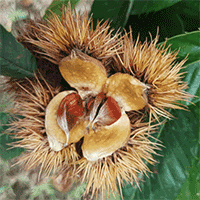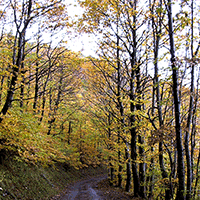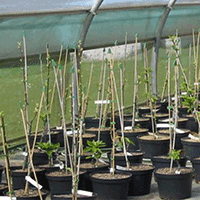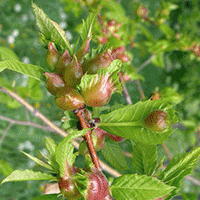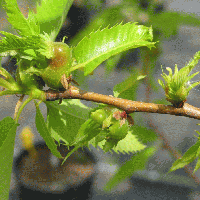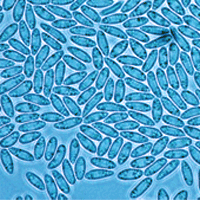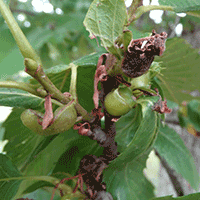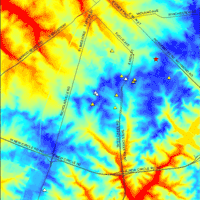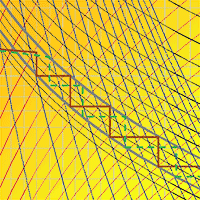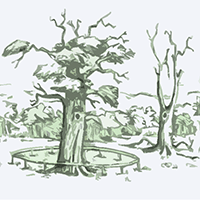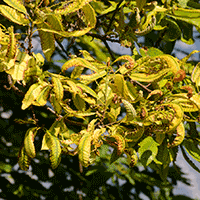
Investigations on yellowing of chestnut crowns in Trentino (Alps, Northern Italy)
Daniela Bertoldi (1), Paolo Miorelli (1), Federico Pedrazzoli (1), Stefano Delugan (2), Marco Deromedi (3), Giorgio Maresi (1)
iForest - Biogeosciences and Forestry, Volume 13, Issue 5, Pages 466-472 (2020)
doi: https://doi.org/10.3832/ifor3488-013
Published: Oct 07, 2020 - Copyright © 2020 SISEF
Research Articles
Abstract
Yellowing of part or the whole canopy of chestnut trees was observed during the summer of 2014 in the areas of Tenno, Pranzo and Drena in Trentino, where chestnut cultivation is traditional on the lateral moraine deposit in a context of a prevalent limestone lithological substrate. Symptoms were observed on chestnut trees of different ages, either grafted or not, scattered or in stripes along the maximum slope. Investigations were carried out in the form of field surveys, chemical and molecular analyses of soil and leaves and greenhouse trials, to assess the damage evolution and its causes. No known pathogens emerged during the field surveys, and laboratory tests excluded the presence of phytoplasma infections. A comparison of yellow and asymptomatic leaves evidenced significant deficiencies of manganese (Mn) and iron (Fe) in the yellow leaves, though the level of the two nutrients was the same in the soil below green and yellowed trees. Experimental run-off trials in the greenhouse reproduced the foliage damage with a continuous basic water regime; open-field fertilizations with Mn and Fe led to a slightly recovery on the part of some treated leaves, thus confirming the hypothesis of a probable, sudden deficiency of the mentioned microelements. A possible explanation of this phenomenon could be, on one side, the high precipitation level of 2014, and, on the other side, the previous outbreaks of the Asian chestnut gall wasp, that had reduced foliage volume and thus the organic substance in the soil. The natural recovery from symptoms was clearly visible in trees after four years in a context of normal rainfall regime and increasing organic acid in the soil, after effective biological control of wasp. Even if related to a particular and rare geological condition, this is the first description of Mn deficiency in Castanea sativa.
Keywords
Chestnut Yellowing, Castanea sativa, Phytoplasmas, Foliar Deficiencies, Manganese
Authors’ Info
Authors’ address
Paolo Miorelli
Federico Pedrazzoli 0000-0002-3841-4650
Giorgio Maresi 0000-0001-6806-6135
Fondazione Edmund Mach, Centre for Technology Transfer, v. E. Mach 1, 38010 San Michele all’Adige, TN (Italy)
Free worker, Trento (Italy)
Fondazione Edmund Mach, Research and Innovation Centre, Department of Sustainable Agroecosystems and Bioresources, San Michele all’Adige, TN (Italy)
Corresponding author
Paper Info
Citation
Bertoldi D, Miorelli P, Pedrazzoli F, Delugan S, Deromedi M, Maresi G (2020). Investigations on yellowing of chestnut crowns in Trentino (Alps, Northern Italy). iForest 13: 466-472. - doi: 10.3832/ifor3488-013
Academic Editor
Alberto Santini
Paper history
Received: Apr 29, 2020
Accepted: Aug 04, 2020
First online: Oct 07, 2020
Publication Date: Oct 31, 2020
Publication Time: 2.13 months
Copyright Information
© SISEF - The Italian Society of Silviculture and Forest Ecology 2020
Open Access
This article is distributed under the terms of the Creative Commons Attribution-Non Commercial 4.0 International (https://creativecommons.org/licenses/by-nc/4.0/), which permits unrestricted use, distribution, and reproduction in any medium, provided you give appropriate credit to the original author(s) and the source, provide a link to the Creative Commons license, and indicate if changes were made.
Web Metrics
Breakdown by View Type
Article Usage
Total Article Views: 35959
(from publication date up to now)
Breakdown by View Type
HTML Page Views: 31288
Abstract Page Views: 1915
PDF Downloads: 2074
Citation/Reference Downloads: 2
XML Downloads: 680
Web Metrics
Days since publication: 1895
Overall contacts: 35959
Avg. contacts per week: 132.83
Citation Metrics
Article Citations
Article citations are based on data periodically collected from the Clarivate Web of Science web site
(last update: Mar 2025)
Total number of cites (since 2020): 3
Average cites per year: 0.50
Publication Metrics
by Dimensions ©
Articles citing this article
List of the papers citing this article based on CrossRef Cited-by.
References
Una fitopatia ad eziologia ancora incerta: il giallume del castagno in Emilia-Romagna e nelle Marche [An uncertain disease: yellowing of chestnut in Emilia-Romagna and Marche]. Sherwood 57: 43-46. [in Italian]
Gscholar
Note illustrative della carta geologica d’Italia alla scala 1:50.000, foglio 080 Riva del Garda [Illustrative notes on Italian geological map 1:50.000, sheet 080 Riva del Garda]. Provincia Autonoma di Trento, LAC, Firenze, Italy, pp. 145.
Gscholar
Abiotic disorders of landscape plants: a diagnostic guide. Agriculture and Natural Resources Publication no. 3420, University of California, Oakland, CA, USA, pp. 242.
Gscholar
Dosage rapide du calcaire actif de sols [Rapid dosage of active limestone in soils]. Annales Agronomiques 12: 441-450. [in French]
Gscholar
Association of phytoplasma with chestnut (Castanea crenata Sieb. et Zucc.) little leaf disease in Korea. Korean Journal of Mycoplasmology 8: 48-54.
Gscholar
Le stime di superficie 2005 - Prima parte [Surfaces estimation 2005 - first part] (Tabacchi G, De Natale F, Di Cosmo L, Floris A, Gagliano C, Gasparini P, Genchi L, Scrinzi G, Tosi V eds). Inventario Nazionale delle Foreste e dei Serbatoi Forestali di Carbonio, MiPAF - Corpo Forestale dello Stato - Ispettorato Generale, CRA - ISAFA, Trento. [in Italian]
Online | Gscholar
Le stime di superficie 2005 - Seconda parte [Surfaces estimation 2005 - second part]. (Tabacchi G, De Natale F, Di Cosmo L, Floris A, Gagliano C, Gasparini P, Salvadori I, Scrinzi G, Tosi V eds). Inventario Nazionale delle Foreste e dei Serbatoi Forestali di Carbonio, MiPAF - Corpo Forestale dello Stato - Ispettorato Generale, CRA - ISAFA, Trento, Italy. [in Italian]
Online | Gscholar
Soil quality - determination of carbonate content - Volumetric method. International Organisation for Standardization, Geneva, Switzerland, pp. 7.
Gscholar
Candidatus Phytoplasma castaneae, a novel phytoplasma taxon associated with chestnut witches’ broom disease. International Journal of Systematic and Evolutionary Microbiology 52: 1543-9.
CrossRef | Gscholar
Development of a DTPA micronutrient soil test. Agronomy Abstract 69: 87.
Gscholar
Mycoplasma-like bodies associated with chestnut yellows. Annals of the Phytopathological Society of Japan 40: 464-468. [in Japanese]
Gscholar
Phylogenetic classification of plant pathogenic mycoplasma-like organisms or phytoplasmas. In: “Molecular and Diagnostic Procedures in Mycoplasmology” (Razin S, Tully JG eds). Academic Press, San Diego, CA, USA, pp. 369-380.
Gscholar
Yellowing disease of chestnut. Annals of the Phytopathological Society of Japan 19: 95.
Gscholar

